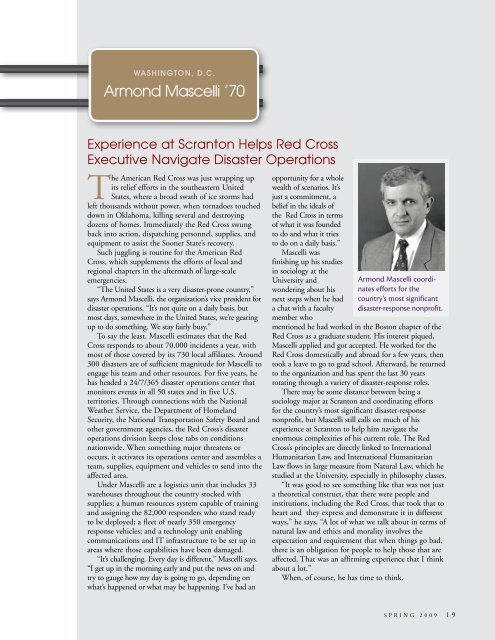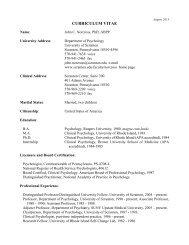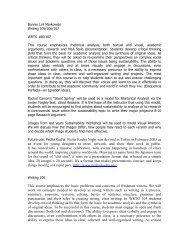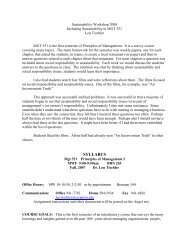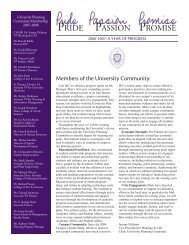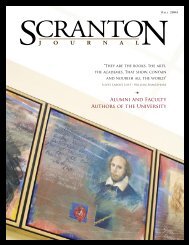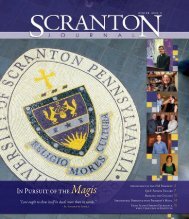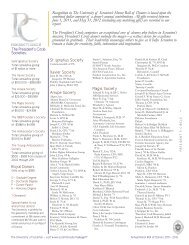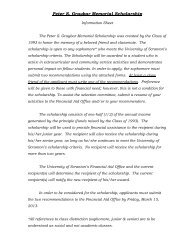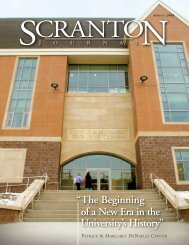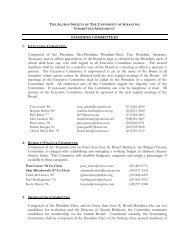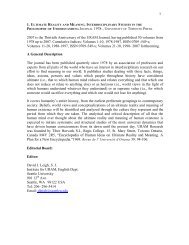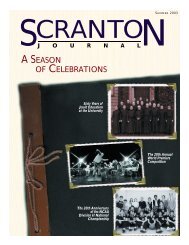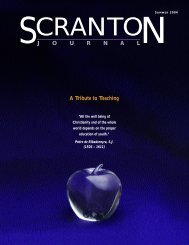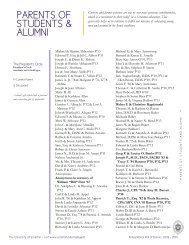SPrING 2009 - The University of Scranton
SPrING 2009 - The University of Scranton
SPrING 2009 - The University of Scranton
Create successful ePaper yourself
Turn your PDF publications into a flip-book with our unique Google optimized e-Paper software.
washington, D.C.<br />
Armond Mascelli ’70<br />
Experience at <strong>Scranton</strong> Helps Red Cross<br />
Executive Navigate Disaster Operations<br />
<strong>The</strong> American Red Cross was just wrapping up<br />
its relief efforts in the southeastern United<br />
States, where a broad swath <strong>of</strong> ice storms had<br />
left thousands without power, when tornadoes touched<br />
down in Oklahoma, killing several and destroying<br />
dozens <strong>of</strong> homes. Immediately the Red Cross swung<br />
back into action, dispatching personnel, supplies, and<br />
equipment to assist the Sooner State’s recovery.<br />
Such juggling is routine for the American Red<br />
Cross, which supplements the efforts <strong>of</strong> local and<br />
regional chapters in the aftermath <strong>of</strong> large-scale<br />
emergencies.<br />
“<strong>The</strong> United States is a very disaster-prone country,”<br />
says Armond Mascelli, the organization’s vice president for<br />
disaster operations. “It’s not quite on a daily basis, but<br />
most days, somewhere in the United States, we’re gearing<br />
up to do something. We stay fairly busy.”<br />
To say the least. Mascelli estimates that the Red<br />
Cross responds to about 70,000 incidents a year, with<br />
most <strong>of</strong> those covered by its 730 local affiliates. Around<br />
300 disasters are <strong>of</strong> sufficient magnitude for Mascelli to<br />
engage his team and other resources. For five years, he<br />
has headed a 24/7/365 disaster operations center that<br />
monitors events in all 50 states and in five U.S.<br />
territories. Through connections with the National<br />
Weather Service, the Department <strong>of</strong> Homeland<br />
Security, the National Transportation Safety Board and<br />
other government agencies, the Red Cross’s disaster<br />
operations division keeps close tabs on conditions<br />
nationwide. When something major threatens or<br />
occurs, it activates its operations center and assembles a<br />
team, supplies, equipment and vehicles to send into the<br />
affected area.<br />
Under Mascelli are a logistics unit that includes 33<br />
warehouses throughout the country stocked with<br />
supplies; a human resources system capable <strong>of</strong> training<br />
and assigning the 82,000 responders who stand ready<br />
to be deployed; a fleet <strong>of</strong> nearly 350 emergency<br />
response vehicles; and a technology unit enabling<br />
communications and IT infrastructure to be set up in<br />
areas where those capabilities have been damaged.<br />
“It’s challenging. Every day is different,” Mascelli says.<br />
“I get up in the morning early and put the news on and<br />
try to gauge how my day is going to go, depending on<br />
what’s happened or what may be happening. I’ve had an<br />
opportunity for a whole<br />
wealth <strong>of</strong> scenarios. It’s<br />
just a commitment, a<br />
belief in the ideals <strong>of</strong><br />
the Red Cross in terms<br />
<strong>of</strong> what it was founded<br />
to do and what it tries<br />
to do on a daily basis.”<br />
Mascelli was<br />
finishing up his studies<br />
in sociology at the<br />
<strong>University</strong> and<br />
wondering about his<br />
next steps when he had<br />
a chat with a faculty<br />
member who<br />
Armond Mascelli coordinates<br />
efforts for the<br />
country’s most significant<br />
disaster-response nonpr<strong>of</strong>it.<br />
mentioned he had worked in the Boston chapter <strong>of</strong> the<br />
Red Cross as a graduate student. His interest piqued,<br />
Mascelli applied and got accepted. He worked for the<br />
Red Cross domestically and abroad for a few years, then<br />
took a leave to go to grad school. Afterward, he returned<br />
to the organization and has spent the last 30 years<br />
rotating through a variety <strong>of</strong> disaster-response roles.<br />
<strong>The</strong>re may be some distance between being a<br />
sociology major at <strong>Scranton</strong> and coordinating efforts<br />
for the country’s most significant disaster-response<br />
nonpr<strong>of</strong>it, but Mascelli still calls on much <strong>of</strong> his<br />
experience at <strong>Scranton</strong> to help him navigate the<br />
enormous complexities <strong>of</strong> his current role. <strong>The</strong> Red<br />
Cross’s principles are directly linked to International<br />
Humanitarian Law, and International Humanitarian<br />
Law flows in large measure from Natural Law, which he<br />
studied at the <strong>University</strong>, especially in philosophy classes.<br />
“It was good to see something like that was not just<br />
a theoretical construct, that there were people and<br />
institutions, including the Red Cross, that took that to<br />
heart and they express and demonstrate it in different<br />
ways,” he says. “A lot <strong>of</strong> what we talk about in terms <strong>of</strong><br />
natural law and ethics and morality involves the<br />
expectation and requirement that when things go bad,<br />
there is an obligation for people to help those that are<br />
affected. That was an affirming experience that I think<br />
about a lot.”<br />
When, <strong>of</strong> course, he has time to think.<br />
Spring <strong>2009</strong> 19


